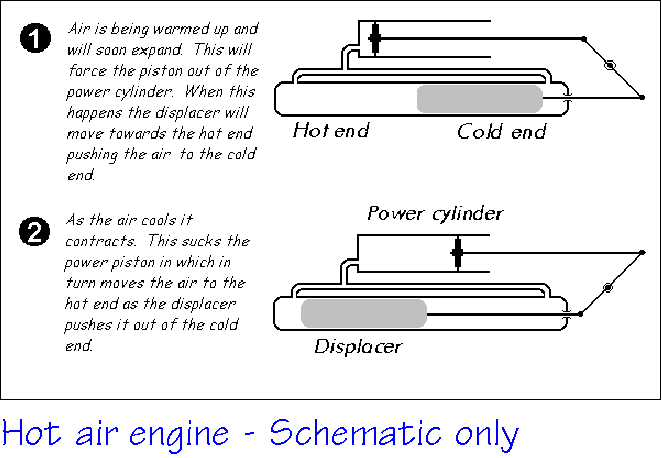Stirling engines :
Novelty or machines for the next millennium?
A Stirling engine can be much more efficient than an IC engine, has no valves, tappets, timing
chains, or ignition to worry about and can be run from any heat source you can think of. The
drawbacks are that it needs time to warm up, has no throttle or governor, needs good cooling
and for performance comparable to an IC engine needs high temperatures and pressures which
push materials technology to the limit. Ideal applications are where there is ample cooling water
and a 'plodding' job to do such as pumping or auxiliary power on a boat. One firm is promoting a
25KW solar powered generator for 3rd world countries which is three times more efficient than
the equivalent solar (photovoltaic) panels. This last has not been lost on NASA who are doing a
lot of research in the field. They have designed a Stirling engine for use in space stations. In
another element, the Swedish navy are getting this year a 60m, 1500t Sterling powered
submarine. Reverse the engine and you get a refrigerator that goes down to extremely low
temperatures. Some night-vision goggles are cooled by miniature sterling engines in this way.
Since 1816 when The Rev Robert Stirling was granted a patent for a new type of air engine
(apparently developed as it had no dangerous boilers that could - and did explode) the hot air
engine has remained almost unknown. These machines have the appeal of arms and rods
oscillating in strange motions without making more noise, being more dirty, or being more
frightening than a sewing machine. DIY kits and novelty engines as well as models expressly for
classrooms are available. There are kits and drawings for making simple Stirling engines in a
couple of hours in a simple workshop. You can buy engines that run by sitting on a coffee cup or
even run off room heat when cooled by ice. I'm hoping to get hold of manufacturers details of as
many of these novelties as I can and perhaps we'll have a family of Stirlings working away, each
with its own strange motion, novelty or purpose.
From the Museum's point of view, Stirling engines are quiet and easy to run, have many different
shapes and mechanisms, and are a good way of explaining heat engines in general. For me the
fascinating thing is that although engines 100 years old or so could be shown, every year there
are modern developments which makes this subject very much a thing of taday and the future
showing how a museum does not just display old history, but showing how old ideas can be
revisited and encourage the technologists of tomorrow.
The griff
Heat a gas up and it wants to expand. If this happens in a cylinder then useful work can be
extracted as the piston is forced out. Then what? In an IC engine the hot gasses are  thrown
away with a loud 'pop' but in a Stirling engine the gas is sealed in. This makes it very quiet, but
now we have to
cool the gas
again before we
can repeat the
cycle. thrown
away with a loud 'pop' but in a Stirling engine the gas is sealed in. This makes it very quiet, but
now we have to
cool the gas
again before we
can repeat the
cycle.
All Sterling
engines have a
hot bit and a
cold bit. The
way most
Sterling
engines get the
gas to go from
cold to hot and
hot to cold
again is by
using a dis-placer. Imagine
a closed
cylinder with
one end hot
and the other
cold. If we
push all the air up to one end it should get hot or cold depending on which end. By moving a
'displacer' from end to end the gas has to go to the other. After a while the displacer is also hot
at one end and cold at the other and might be a sort of 'brillo-pad' that lets the air through and
heat up or cool down efficiently. The principles are the same in all engines but there are very
many different layouts and variations.
|
Now you have the basics look at Wikepedia
 thrown
away with a loud 'pop' but in a Stirling engine the gas is sealed in. This makes it very quiet, but
now we have to
cool the gas
again before we
can repeat the
cycle.
thrown
away with a loud 'pop' but in a Stirling engine the gas is sealed in. This makes it very quiet, but
now we have to
cool the gas
again before we
can repeat the
cycle.